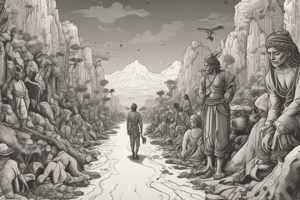Podcast
Questions and Answers
What is culture comprised of?
What is culture comprised of?
- Only traditional customs and beliefs
- Only physical objects
- Only intellectual and moral ideas
- The sum total of human creation, including intellectual, technical, artistic, physical, and moral (correct)
Why is it important to view cultures as integrated systems?
Why is it important to view cultures as integrated systems?
- To study the impact of culture on the environment
- To understand how cultures change over time
- To compare cultures with one another
- To see how particular culture traits fit into the whole system (correct)
What is the primary way that humans acquire culture?
What is the primary way that humans acquire culture?
- Through random chance
- Through instinctual behavior
- Through genetic transmission
- Through learning and interacting with one's environment (correct)
What is the main advantage of human culture in adapting to environmental stresses?
What is the main advantage of human culture in adapting to environmental stresses?
What is a necessary condition for an idea or behavior to be considered cultural?
What is a necessary condition for an idea or behavior to be considered cultural?
What is the analogy used to describe the integrated nature of culture?
What is the analogy used to describe the integrated nature of culture?
What is the primary characteristic of symbols in human culture?
What is the primary characteristic of symbols in human culture?
What is the term used to describe the customary activities and tools that aid humans in adapting to their environment?
What is the term used to describe the customary activities and tools that aid humans in adapting to their environment?
What is the scope of culture in terms of its impact on human lives?
What is the scope of culture in terms of its impact on human lives?
What is the term for the process by which an individual learns the rules and values of their culture?
What is the term for the process by which an individual learns the rules and values of their culture?
Study Notes
Characteristic Features of Culture
- Culture is not inherited genetically, but rather acquired through learning and interaction with one's environment.
- Human beings rely heavily on learned behavior patterns for their survival, with no instinct genetically programmed to direct behavior.
- The process of acquiring culture after birth is called enculturation, where an individual learns the rules and values of their culture.
Culture Is Shared
- For a thing, idea, or behavior pattern to be considered "cultural", it must have a shared meaning among at least two people within a society.
- Shared culture is essential for a society to operate effectively, enabling communication and cooperation among its members.
Culture Is Symbolic
- Symbolic thought is unique and crucial to human cultural learning, where symbols represent abstract ideas and concepts.
- Symbols can be verbal or nonverbal, and their meaning is not always obvious, but they can trigger powerful emotions and behaviors.
Culture Is All-Encompassing
- Culture encompasses all aspects of human life, including material and non-material elements, such as man-made objects, ideas, and activities.
- Culture is the sum total of human creation, including intellectual, technical, artistic, physical, and moral aspects, and is dynamic, changing with environmental conditions.
Culture Is Integrated
- Cultures are integrated wholes, with interconnected parts that make sense within their context.
- A change in one aspect of culture can generate changes in other aspects, similar to a living organism.
Culture Can Be Adaptive and Maladaptive
- Humans have both biological and cultural ways of coping with environmental stresses, using "cultural adaptive kits" to aid adaptation.
- Culture has allowed humans to adapt to various ecological conditions, making them unique among species.
Studying That Suits You
Use AI to generate personalized quizzes and flashcards to suit your learning preferences.
Description
Learn about the key features of culture, including how it's learned and acquired through environmental interactions.




